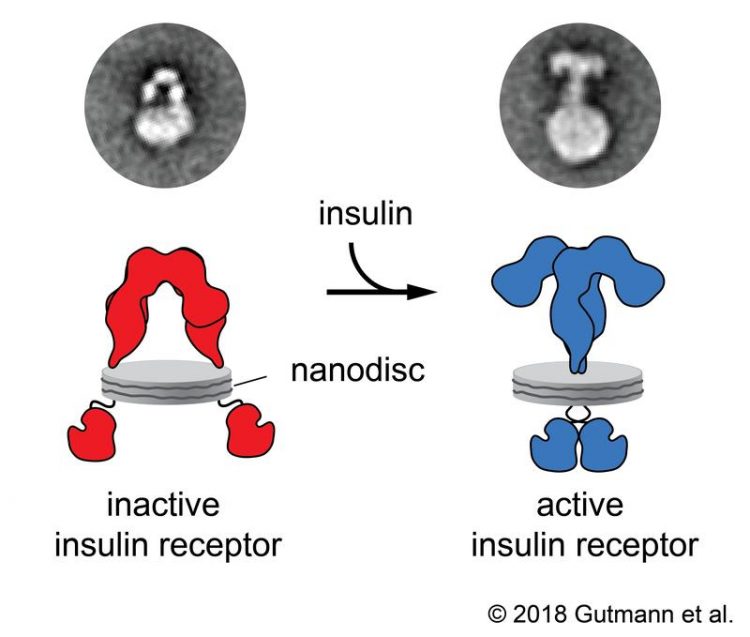How the insulin receptor works

How the insulin receptor works © Gutmann et al. 2018
Insulin exerts multiple effects on cellular metabolism and growth. The biological actions of insulin are mediated by a cell-surface receptor, called insulin receptor, which is present on the surface, i.e. the plasma membrane, of virtually all mammalian cells. The dysfunction of insulin receptor has been linked to severe pathologies including diabetes mellitus or cancer.
Insulin binds outside the cell to the extracellular domain of its receptor and induces a structural change that is propagated across the membrane to the intracellular kinase domains inside the cell, causing them to activate each other, thus initiating signaling cascades. The nature of this structural change remained a mystery for decades, resulting in mutually exclusive models for insulin receptor activation being put forward.
“To obtain insights into receptor activation, we purified full-length insulin receptors and embedded them into nanodiscs, which are, as their name suggests, nanoscale disc-shaped membrane patches. Those could then be directly visualized by single-particle electron microscopy,” explains Theresia Gutmann, PhD student and co-first author of the study. She works at the Institute for Pancreatic Islet Research/Paul Langerhans Institute Dresden (IPI/PLID) which is run by Helmholtz Zentrum München together with the University Hospital Carl Gustav Carus of Technical University Dresden.
“This technology enables us to directly study the cell-surface receptors in an artificial membrane environment”, explains Dr. Ünal Coskun, group leader at IPI/PLID and co-senior author of the study. “In the absence of insulin, the receptor displays an inverted U-shaped ectodomain, which is consistent with previous crystallographic studies of isolated ectodomains, implying that the membrane-passing transmembrane domains and thus kinase domains are held well apart from each other.”
“Upon insulin binding, the ectodomain of the receptor undergoes a dramatic reorganization, changing from a U-shaped to a T-shaped structure and also causing a rearrangement of the transmembrane domains. These now come together likely facilitating kinase domain interactions and thus their activation”, Dr. Thomas Walz, professor at the Rockefeller University, continues.
Dr. Coskun summarizes: “These nanodisc-embedded receptors provide a novel platform to address further questions regarding insulin receptor regulation and eventually to test therapeutic agents.” “Our results directly demonstrate the structural transition in the full-length receptor upon insulin binding and offer an answer to the longstanding question concerning the mechanism by which insulin activates its receptor, thus improving our understanding of the receptor,” concludes Gutmann. The authors from Dresden are scientists in the German Center for Diabetes Research (DZD). The results of this collaborative work have now been published in the ‘Journal of Cell Biology’.
Further Information
Original Publication:
Gutmann, Kim et al. (2018): Visualization of ligand-induced transmembrane signaling in the full-length human insulin receptor. Journal of Cell Biology, DOI: 10.1083/jcb.201711047
The Helmholtz Zentrum München, the German Research Center for Environmental Health, pursues the goal of developing personalized medical approaches for the prevention and therapy of major common diseases such as diabetes and lung diseases. To achieve this, it investigates the interaction of genetics, environmental factors and lifestyle. The Helmholtz Zentrum München is headquartered in Neuherberg in the north of Munich and has about 2,300 staff members. It is a member of the Helmholtz Association, a community of 18 scientific-technical and medical-biological research centers with a total of about 37,000 staff members. http://www.helmholtz-muenchen.de/en
The Institute for Pancreatic Islet Researcht (IPI) focuses on basic and clinical research on pancreatic beta cells, which are responsible for production and secretion of insulin. http://www.helmholtz-muenchen.de/en/ipi
The German Center for Diabetes Research (DZD) is a national association that brings together experts in the field of diabetes research and combines basic research, translational research, epidemiology and clinical applications. The aim is to develop novel strategies for personalized prevention and treatment of diabetes. Members are Helmholtz Zentrum München – German Research Center for Environmental Health, the German Diabetes Center in Düsseldorf, the German Institute of Human Nutrition in Potsdam-Rehbrücke, the Paul Langerhans Institute Dresden of the Helmholtz Zentrum München at the University Medical Center Carl Gustav Carus of the TU Dresden and the Institute for Diabetes Research and Metabolic Diseases of the Helmholtz Zentrum München at the Eberhard-Karls-University of Tuebingen together with associated partners at the Universities in Heidelberg, Cologne, Leipzig, Lübeck and Munich. http://www.dzd-ev.de/en/index.html
Contact for the media:
Department of Communication, Helmholtz Zentrum München – German Research Center for Environmental Health, Ingolstädter Landstr. 1, 85764 Neuherberg – Tel. +49 89 3187 2238 – Fax: +49 89 3187 3324 – E-mail: presse@helmholtz-muenchen.de
Scientific Contact at Helmholtz Zentrum München:
Dr. Ünal Coskun, Helmholtz Zentrum München – German Research Center for Environmental Health, Institute for Pancreatic Islet Research, Fetscherstrasse 74, 01307 Dresden – Tel. +49 351 796 5340 – E-mail: uenal.coskun@helmholtz-muenchen.de
Media Contact
All latest news from the category: Life Sciences and Chemistry
Articles and reports from the Life Sciences and chemistry area deal with applied and basic research into modern biology, chemistry and human medicine.
Valuable information can be found on a range of life sciences fields including bacteriology, biochemistry, bionics, bioinformatics, biophysics, biotechnology, genetics, geobotany, human biology, marine biology, microbiology, molecular biology, cellular biology, zoology, bioinorganic chemistry, microchemistry and environmental chemistry.
Newest articles

Decoding Cancer: 40 Years of Breakthroughs in Genetic Research
Cancer in children and adolescents is rare. Nevertheless, malignant diseases are still one of the most common causes of death in this age group. Survivors of childhood or adolescent cancer…

Let’s Think Before the First Drink: How Early Substance Use Might Lead to Brain Structure Differences Among Adolescents
Many differences appeared to exist prior to any substance use, pointing to the role brain structure may play in substance use risk, NIH-supported study suggests. Studies reveal factors that expose…

Combating Kidney Cancer Using Enhanced Immunotherapies
Medical University of South Carolina Hollings Cancer Center researcher receives Department of Defense Early Career Scholar Award to improve immune therapies by targeting resistant kidney tumors. A Medical University of…



